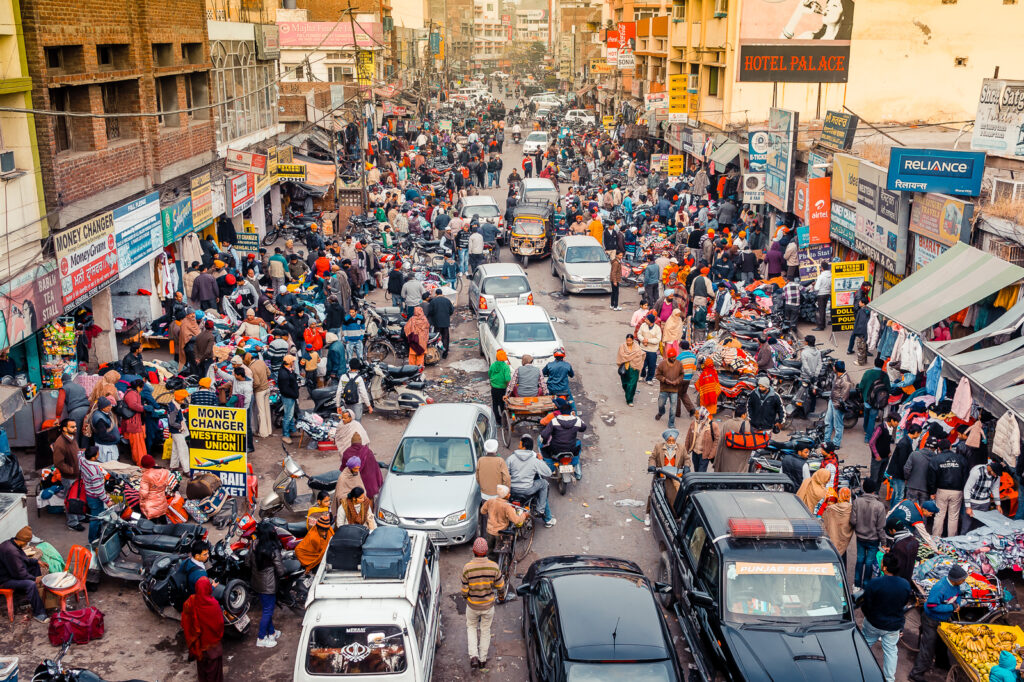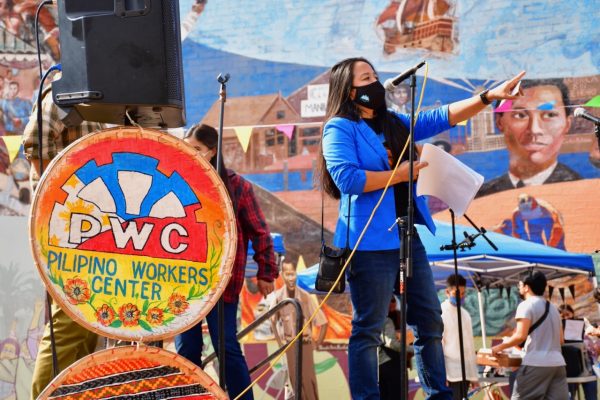A recent and sweeping “Southern” turn has occurred in the field of urban studies, building on years of decolonial struggles, third world solidarities, and shifts toward more globalized analyses of social phenomena. While important questions remain about the ontological or geographical distinctiveness of a “Global South,” new engagements with “Southern” urban dynamics have amplified neglected dimensions of the study of urban life.
Urbanization refers to the specific structural conditions generated through efforts to maximize land value, concentrate economic activities, and accumulate profit through the efficient interchanges of markets, industries, administrations, and bodies. Each of these facets intersects with a wide range of histories, sensibilities, settlement practices, and geographies to produce distinct environments. If “Northern” cities are characterized by systematic regulations, governance apparatuses, and a formalized design of economic growth, “Southern” cities have, in the absence or weakness of such characteristics, drawn attention to how cities exude vitality through alternative kinds of urbanizing relations. They reflect how different kinds of bodies—their stories, experiments, and determinations—find ways to relate to each other while simultaneously creating spaces of autonomy. In so doing, they generate new ideas and practices.
Southern urbanisms ask important questions about what makes a life viable. Southern urban life—exposed to various forms of plunder, exploited as testing grounds for half-baked ideas and policies, and deprived of the material and institutional resources needed to govern growing populations judiciously—often depends on the coexistence of radically different ways of seeing and experiencing. Streets can be domestic, entrepreneurial, liminal, festive, and predatory spaces. Markets can be converted into informal “universities” or rehearsal spaces for performances. Interiors of households can be way stations for those passing through, collective kitchens, and “specialty” centers for specific services or information. A kiosk might also serve as a nerve center for social exchanges, a supervised place for kids to do their homework, a gathering place for small time entrepreneurs, or a place to leave messages. A church or mosque may draw people from various regions and walks of life and then connect them through unions, women’s groupings, savings clubs, or recreation centers. Each space presents a crossroads, a place to encounter people from other backgrounds and affiliations.
Solomon Benjamin describes Chennai, India’s Ritchie Street as one such place, where visiting traders, service engineers, and religious and secular teachers—across ethnicity and class—converge at 5 p.m. every evening at a set of shops that sell north Indian samosas, sweet ginger tea, and sugarcane juice. These congregations gossip on trade and family alliances, but also form new social and financial relationships.
This essay is featured in Imagining Global Futures.
Indeed, in the absence of structural assistance, many must find alternative ways to capitalize on loopholes, tenancies, and friendship networks to supplement their incomes. These alternatives create a transactional infrastructure that can be mobilized to influence political authorities, invest in affordable housing, and improve urban services. My own work examines the vast networks of textile production in Jakarta, tracking the decentralization of large-scale factory production into hundreds of small units. Each specializes in one facet of clothing production—designing, cutting, patterning, sewing, buttoning—yet all vertically integrate into a few large corporate structures. The low-paid, often female, workers in these units have developed a substantial lateral chain of production and marketing that operate independently of corporations through intersecting memberships in religious and women’s associations, impromptu popular markets, unions in the ports, and eating places where truckers congregate.
While these efforts tend to be viewed as reflecting the resilience of urban inhabitants in the face of hardship, a more accurate analysis would realize the labor involved in piecing together “territories of operation.” Systematic efforts create these possibilities. It is not resilience alone that opens access to resources and spaces of maneuver.
This is not to diminish the difficulties that many households face in making ends meet, nor the persistent ways that communities are undermined, hemmed in, and subject to debilitating conflicts. From long-term neglect to explicit assault on livelihoods, many urban populations are simply worn down in the face of sustained, inordinate difficulties in securing basic needs. Chronic insufficiency poses especially hard challenges for households with children. The children and young people who strive for different futures often must take seemingly desperate measures to make ends meet.
I spent my life across a host of cities in what we call the Global South. In these places, children and young people often congregate on university campuses to scavenge for food and handouts; others provide casual labor to transport hubs and ports; others still canvass the nightlife districts, preying on single women, organizing raids on large markets, carjacking, holding up passengers on taxis and buses, or targeting foreign workers. Some carry out revenge for the affronted and the jealous, perform tricks, carry loads, deliver messages, stand guard by parked cars or empty lots, or offer makeshift security services for customers at money exchanges. Others extort shopkeepers or hang around jails awaiting families bringing food to their relatives. Some invade funerals at cemeteries, steal from drug lords, or loiter in the shadows of local police stations. In far larger numbers, many deliver, load and unload, and clean and care for wages barely more than gratuities. Through modes both legal and extralegal, these children keep cities afloat by providing their time to more privileged urban residents.
These young people expose the city as a jumble of spaces of interruption, a patchwork of enclosures, gaps, and itineraries. They reveal how built environments and infrastructures—alongside the regulatory apparatuses that govern everyday transactions—are replete with ellipses, stutters, and circuits of theft. Violence, of course, is an integral aspect of these spaces, as youths must seize and hold opportunities and territories. These “economic activities” are rarely sufficient to meet everyday needs, and young people are perpetually hungry. But no matter how violent, brutal, and extractive, these everyday activities amplify the city as a domain of struggle and necessity.
These young people live not so much beyond the “pale” but amid the city, often in full view. They are typically outside the scope of law enforcement, but they can be eliminated by the police at any time without recourse to any appeal. They endure because, even without regular jobs, a task always needs to be done and their availability makes them a source of cheap labor. They endure because the city is full of unpredictable openings. They endure because theft has so long been layered into these cities’ functioning. All inhabitants have been the objects of theft, and despite the moralism that insists theft is a crime, there is a tacit recognition that the city—which memorializes a grand theft—cannot survive without it.
But more importantly, the city’s apparent and widespread brokenness—the infrastructure disrepair, the severe contraction of civil service employment, the remnants of failed import substitutions, the materializations of neoliberal austerity—extends itself as a resource for these youth who have almost nothing.
Ironically, the city gives through its brokenness. It produces states of absolute destitution but then offers solutions through the logic of its own operation. Contrary to conventional understandings, opportunities open when authorities fail to police every space, when waste collection fails to gather all the trash, when electricity does not reach all corners, when surveillance cameras cannot capture every activity. The borders of shops can extend themselves into the streets, and families and institutions can extend their disciplinary practices across many assemblies.
These extensions counter the notion of property as something to be marked off or defended. These extensions point to ways that territories and institutions leak and reach outward into a larger world, shapeshifting along the way to become something else. They reveal ways that surveillance, captivity, and dissolution have compelled people to extend their spaces and senses of intimacies. The apartment block extends into a series of kiosks: resting spaces for motorbike taxi drivers, “backyard shacks” that host music clubs and card games, makeshift shelters for those awaiting transport, vegetable and flower gardens, or impromptu car washing businesses. Different actors create these spaces under different pretexts, negotiations, claims of proprietorship, and responsibilities for maintenance. They blur not only a sense of intended purpose but also questions of authority—of who oversees what.
Extensions also lead to the vast hinterlands of cities where increasingly large numbers of poor and working-class residents live. These spaces patch together built environments—factories, farmlands, migrant hostels, megacomplexes, shopping malls, and cheap housing—in uneasy proximity. Often without clear connections, these spaces are open to various uses. Here the “South” unsettles the ruling calculus of what counts as a life worth living, piecing together activities that cut across borders even as borders remain stubborn and exclusionary.
Across the world much of urban economic value is centered on the consumption of social experience: cities bet their futures on how many different identities, events, and trends they can offer. Both old and new “popular economies” of many Southern cities work to build connections, through improvised markets, community associations, and gatherings. These serve as vehicles for information exchange, planning, and social connections. Moreover, they promote mutual aid. Households might take in relatives or friends; neighbors or extended families might produce goods together or share resources, income, and materials; impromptu commercial associations and trade groups might pool resources and influence to access affordable supplies and open up new markets; religious institutions, local authorities, small enterprises, care centers, or resident associations might come together to provide resources to each other.
These efforts reflect an ethos of availability, a capacity to do things differently. They enable people to “try on” ways of associating with each other regardless of whether they will work and without any expectations that they be prolonged or institutionalized.
In Lagos, Nigeria, in the face of arbitrary and ruthless practices of policing and security, they call the long-honed, street-level circulation of information radio trottoir. People take to social media to circulate information. Across Freetown, Sierra Leone, neighborhoods testify to each other, a mode of communication that enabled Leonians to eventually piece together an effective response to Ebola. In neighborhoods in Luanda, Angola, the circulation of TikTok content, music clips, and WhatsApp videos enable a sense of connection in the face of state attempts to concentrate power by dividing the city.
Though these methods of communication are not perfect, they emphasize availability: a willingness to put messages, images, experiences, and thoughts into the world to be tried out and reworked. In Agadez, Niger, a key city in transmigration from West Africa to the Mediterranean increasingly subject to European surveillance, women’s associations adopt passing migrants as their own children to lessen conflicts about who belongs. Meanwhile, young people in Abidjan, Côte d’Ivoire “find” their identities across a wide range of jobs, hustles, and identifications and depend on displaying particular brands or styles as a way to mark social status and assert strong identities.
Beyond the resilience and innovation that these practices reflect, they also reveal forms of computation—combining materials at hand to create space where people can eke out some kind of living and sense of belonging. These practices occur where materials are limited and subject to contradictory demands, loyalties, and responsibilities. This makes it difficult for urban residents to know what to prioritize: what is important to pay attention to, what course of action is best, or even which pressures to respond to. Sometimes uncertainty is appropriate in considering how to put limited resources to work. Sometimes it makes sense to hold things back.
Of course, the social cooperation and improvisational networks of information circulation can become resources for states and other institutions. They can use creativity from below to shed their responsibilities for social welfare and cut costs. States also frequently prey on the fear of impoverishment, particularly in cities where industrial and public sector jobs have disappeared, and forms of informal entrepreneurship have become overcrowded. In some cities, ruling political machines stoke ethnic and religious conflict, upending long traditions of mutual accommodation. In others the proliferation of violence and environmental danger alone generate fear that local assets will be devalued.
Over the past several decades, working communities have adopted diverse forms of activism to draw attention to their challenges. In Southern cities these efforts and rare victories continue to model more judicious forms of urban life. They have succeeded in improving security through in situ upgrades, land-sharing, and work compensation packages. In some instances, residents have mobilized to gain specific rights to services and citizenship. For instance, Black residents of Cali, Colombia resisted a government tax proposal that threatened their livelihoods; residents of Khartoum, Sudan flooded the streets to demand an end to military rule; the Shaheen Bagh encampments of largely Muslim women in Delhi, India created a new kind of public sphere; the #NiUnaMenos feminist initiatives defined the terms of gender and social reproduction in Latin America. These movements—whether independently or in alliance with professional associations and NGOs—are complemented by initiatives for climate justice.
More frequently, however, low-income residents find themselves hedged by surveillance regimes, inhospitable built environments, long commutes, and shrinking aspirational horizons. From demonetization in India, to extrajudicial assassinations in the Philippines, to the entrenching of Blackness as criminal in Brazil, new assaults on the poor around the world limit their capacity to survive outside of repressive regimes. Meanwhile, the engineering of wider chasms between low-income and working-class residents diminishes their familiarity with one another and undermines the possibility of political alliances.
While the gap between low-income and working-class residents grows, working- and lower-middle-class residents are being corralled together into so-called affordable housing in large scale residential towers. In many cities across the South, these complexes are becoming the predominant form of housing for the masses, who are united only in their refusal to consider these places “home.” The attachment to a stable home in places such as Jakarta, my adopted city, is diminishing in favor of movement.
Observers of the towers in Jakarta might see mostly “silent” contestations among residents and lifestyles: Islamic and LGBTQ youth, young professionals, barely middle-class families, immigrants, and sex workers jostle for control over floors in specific buildings. Yet the density of so much difference together ensures that stories, rumors, and information circulate. Meanwhile, the many variations of people passing through and staying more permanently means that identities are never clear.
The towers act as a means of compression—different trajectories are compressed in a generic form. Though different ways of being are at play, clearly distinguishing them becomes impossible. The forms of opacity this produces allows residents to conduct their diverse lives under the radar. The towers are an arena without definition, a place that lacks specific criteria for belonging yet engenders a sense of being-in-concert.
This fluidity is particularly important for a younger generation that increasingly views the cities they come from as irrevocably damaged and limited—where the benefits of citizenship, training, compliance, and civic involvement have little relevance. How can the growing lack of confidence in the capacity of government, expansion of improvised forms of social security, and intense mobility of individuals across different geographies forge new modes of social authority and valuation? In increasingly segregated, fragmented, and provisional terrains, what are the incipient lines of interconnection that allow spaces of mutual collaboration? What social “glue” melds forms of collective action across different public spheres—from neighborhood churches, to squatter settlements, to gated communities? These are the critical “urban” questions today.
There is much to learn from the most oppressed and seemingly marginal urban areas. In Jayapura, West Papua, burdened by its long struggle with Indonesia over self-determination, the logic of extensions and ethos of availability are clear. For the Papuan inhabitants of the city, outnumbered by migrants and mired in brutal impoverishment, their only resource is one another. Here the notion of gathering as extension is critically important. It is a way to bring together family members, friends, and associates to witness their copresence—to talk, touch bodies, eat, drink, dance, joke, and pray. Here hierarchies can be disrupted through the unruliness of gathering. While deals may be made and obligations reinforced, the experience nonetheless reaffirms the volatility of connection. It points to new futures, even those already being performed, and offers hope. These extensions are less structural, coded by exchange relations, than technical in that they conjure things underway without a knowable destination.
The invention of the city as a place of experimental gatherings—despite impediments and without guarantees of progress—amplifies the South’s enduring contribution to urban knowledge and life. Across streets both nurturing and brutal, events can easily switch and undermine the best laid plans and intentions. Yet the possibility remains for residents to turn to each other, rather than on each other, for new ideas and solidarities. The effects of collective action may not always be recognizable or measurable, but they reveal that there are, indeed, endless ways to live together. These possibilities are increasingly significant in the face of the dangerous times here and to come.









